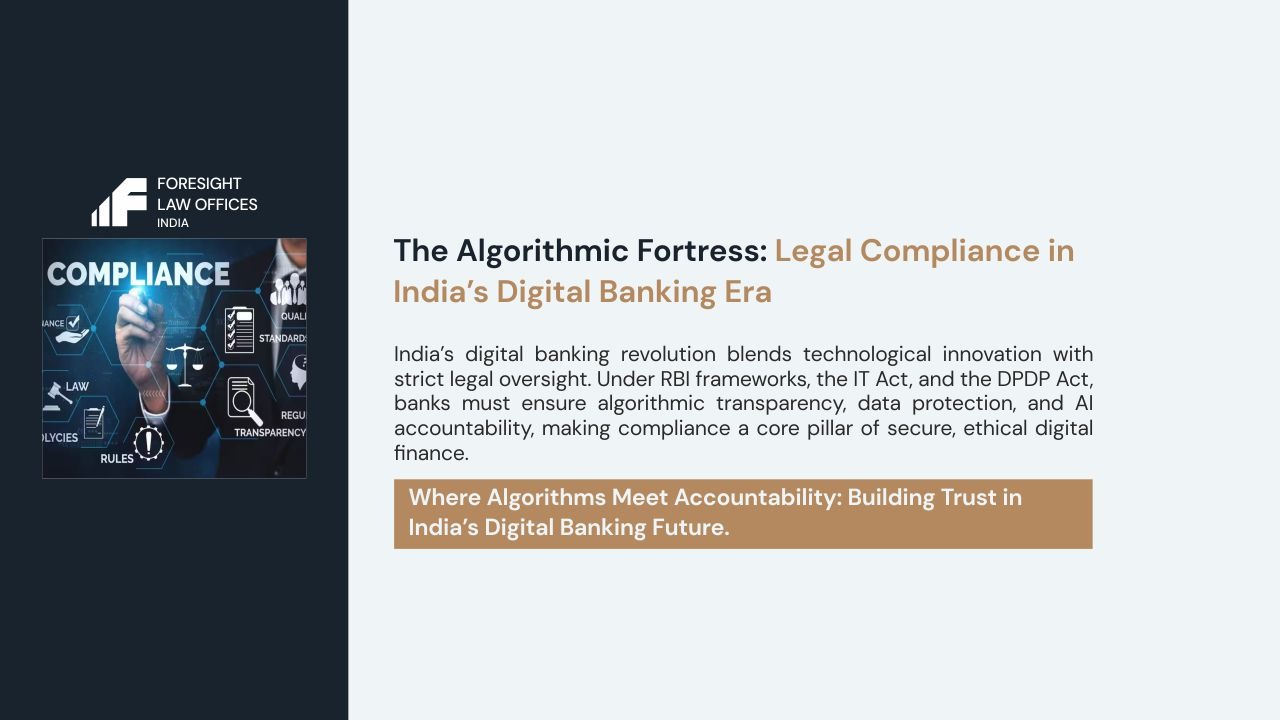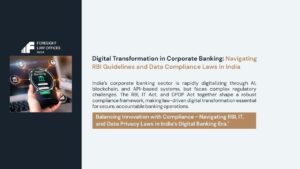The transformation of the Indian banking landscape from brick-and-mortar fortresses to agile digital platforms is one of the most compelling economic stories of the 21st century. What began as a gradual move toward paperless banking has now exploded into a hyper-efficient digital ecosystem built on automation, analytics, and artificial intelligence (AI). Corporate and retail banks alike are using these digital banking platforms to onboard customers, assess creditworthiness, and detect fraud with unprecedented speed.
This revolution, however, is not merely a technological triumph; it is a foundational legal convergence. Every digital process in banking today, from paperless Know Your Customer (KYC) verification to AI-driven risk scoring, operates within a rapidly evolving, complex framework of laws, circulars, and compliance mandates.
As of late 2025, India’s regulators, primarily the Reserve Bank of India (RBI), have erected clearer guardrails under the Digital Lending Directions, 2025, the RBI’s KYC Master Directions, the Information Technology Act, 2000, and the newly potent Digital Personal Data Protection Act, 2023 (DPDP Act).
The Operational and Regulatory Backdrop
1. The Digital Trajectory: Data and Penetration
India’s journey toward financial inclusion and digital supremacy is quantifiable. The success of the Unified Payments Interface (UPI) and the foundational infrastructure of Aadhaar has created an unparalleled digital highway. According to the RBI’s Financial Inclusion Index (FI-Index), there has been a significant upward trend, reflecting growth across Access, Usage, and Quality of financial services.
| Metric | Value (As of March/August 2025) | Source |
| RBI Financial Inclusion Index (FI-Index) | 67.0 (up from 64.2 in Mar 2024) | RBI |
| Adult Account Ownership | 89% | Global Findex 2025 |
| Annual Digital Payment Volume | Expected >130 Billion transactions by end-2025 (Mostly UPI) | Worldline/Industry Estimates |
| AI/ML Integration Benefit | Reduced compliance/operational duration by up to 66% | Industry Analysis |
This robust data highlights a simple truth: digital banking is no longer a niche service; it is the dominant mode of financial engagement, making regulatory compliance non-negotiable for system stability.
2. The Shift to Paperless Compliance in Banking
The move from traditional, document-heavy banking to fully digital compliance began with a single goal: ease of doing business and speed of execution. Corporate clients and retail consumers now expect seamless onboarding and verification, often without visiting a branch.
To facilitate this, the RBI and the Government of India have progressively modernised the KYC regime. The RBI’s Master Direction on KYC (updated in June 2025) now recognises multiple digital and paperless modes for verifying identity and address.
The Digital KYC Triumvirate: Speed, Security, and Scope
The adoption of digital KYC methods offers clear trade-offs between speed, security, and the scope of permissible activities (e.g., low-risk vs. high-risk accounts).
| Digital KYC Method | Primary Mechanism | Estimated Time (Minutes) | KYC Scope |
| e-KYC (Aadhaar OTP) | OTP Validation & XML Data Fetch | $<1$ | Standard (Retail, Mutual Funds, Wallets) |
| V-CIP (Video-KYC) | Real-Time Video, AI-Liveness Check, Geo-Tagging | $3-5$ | Full KYC (Savings, Current, High-Value Loans) |
| NFTF (Non-Face-to-Face) | Document Upload + OTP + Database Check | $5-10$ | Limited/Specific Financial Products |
The Video-based Customer Identification Process (V-CIP) is the most sophisticated and legally robust mechanism. It allows for the remote onboarding of individuals, and the June 2025 amendment specifically expanded its eligibility to include corporate and partnership clients, enabling directors or authorised signatories to complete verification digitally. This single move unlocked digital lending and corporate account opening for millions of businesses, but it necessitates extremely high standards of compliance regarding video recording, data storage, and audit trails.
3. Legal Foundation: e-Signatures and the IT Act, 2000
One of the most significant enablers of all digital contracts in banking is the legal recognition of electronic signatures and authentication mechanisms under the Information Technology Act, 2000.
- Section 5 of the IT Act grants legal validity to electronic signatures, provided they meet criteria for reliability and authenticity. The law treats an electronic signature as having the same legal effect as a physical signature, provided it is executed using a Digital Signature Certificate (DSC) issued by a licensed Certifying Authority (CA) or the Aadhaar-based eSign framework (Section 3A).
- Banking Practice: The RBI’s Master Circular on Digital Payment Security Controls (2021) confirms that e-signatures are recognised for opening accounts, executing loan/facility agreements, and filing regulatory declarations. This shift ensures that in the corporate banking context, multi-million rupee loan documentation, board resolutions, and escrow instructions executed via e-sign are legally binding, provided the integrity and non-repudiation of the signature process are maintained through secure audit trails.
The Complexity of Algorithmic Accountability
The Rise of AI-Based Risk Management in Lending
As digitalization matures, banks are aggressively leveraging AI and Machine Learning (ML) to automate credit assessments, monitor risk exposure, and flag potential frauds. This moves beyond simple rules-based systems to complex predictive analytics:
- AI models score corporate borrowers using a wide array of unstructured data, including transaction history, GST filings, and social media sentiment (for MSMEs).
- Predictive analytics models detect loan delinquency by monitoring thousands of variables in real-time.
- Automated compliance screening uses Natural Language Processing (NLP) to check vast customer databases against RBI’s Anti-Money Laundering (AML) norms and sanctions lists.
This reliance on autonomous systems introduces new legal and ethical challenges: namely, transparency, accountability, and the risk of algorithmic bias in decision-making.
Regulatory Guardrails: RBI’s Digital Lending Directions 2025
To impose consistency and borrower protection across this automated landscape, the RBI issued the Reserve Bank of India (Digital Lending) Directions, 2025. This is a consolidated code governing banks (REs), NBFCs, and their fintech partners (LSPs).
| Regulatory Principle | Core Compliance Mandate | Accountability Line |
| Data Governance & Consent | Regulated Entities (REs) can process only minimum required data. Consent must be specific, explicit, and revocable. | DPDP Act & RBI Cyber Framework |
| Ultimate Accountability | Even if an AI/ML algorithm determines eligibility, the Regulated Entity (RE) remains solely responsible for the loan decision and all outsourced activities. | RE (Bank/NBFC) |
| Explainability (Ethics) | Automated decisions, especially adverse outcomes (rejections), must be explainable to the borrower and reviewable by a human officer (Human-in-the-Loop). | RBI Fair Practices Code |
| Transparency (KFS) | Borrowers must receive a Key Fact Statement (KFS) detailing all loan terms before acceptance and disclosing the involvement of AI tools in decision-making. | RBI Consumer Protection |
| Vendor Management | AI/Fintech vendors (LSPs) must be contractually bound to adhere to the RE’s compliance, data, and operational risk standards. | Contractual & Regulatory Oversight |
This framework explicitly mandates that compliance officers must now audit the logic and training data of the AI models, not just the systems hosting them.
Data Protection Under the DPDP Act 2023: The Privacy Paradigm
The full operationalisation of the Digital Personal Data Protection Act, 2023, fundamentally changes the risk matrix for banks. Banks are designated as “Data Fiduciaries” and must adhere to stringent new obligations:
- Consent Management: Banks must obtain granular, explicit, and informed consent before processing personal or sensitive financial data. Old ‘boilerplate’ clauses are now non-compliant.
- Data Fiduciary Responsibility: Banks are responsible for lawful processing, maintaining data quality, and implementing state-of-the-art security measures.
- Data Breach Reporting: The Act mandates timely reporting of any cyber incident or unauthorised access to the Data Protection Board (DPB) and affected Data Principals (customers).
- Cross-Border Data Transfers: Data transfer is permitted only to government-notified countries, reinforcing data localisation policies for sensitive financial data.
- Penalty Exposure: Non-compliance invites heavy financial penalties, potentially reaching up to ₹250 crore for severe breaches.
The convergence of the DPDP Act with the RBI’s stringent Cybersecurity Framework (2016) means that data security is now subject to a dual regulatory risk profile, increasing the urgency for investment in RegTech (Regulatory Technology) solutions.
The Cost of Non-Compliance: A Punitive Environment
The regulatory environment is increasingly punitive, demonstrating the RBI’s zero-tolerance policy for deficiencies in KYC and AML standards. The recurring imposition of monetary penalties across the financial sector underscores the gravity of compliance failure.
| Regulatory Action (Sample) | Focus of Non-Compliance | Penalty Type |
| Q3-Q4 2023-2024 Fines (Major Banks) | KYC Master Direction, AML Norms, Lending Directions, Fraud Classification | Monetary Penalties (Crores) |
| Q2-Q3 2025 Fines (Co-operative Banks/NBFCs) | Non-updation of KYC, Failure to classify accounts as per risk profile | Monetary Penalties (Lakhs) |
| DPDP Act (Potential) | Failure to obtain valid consent, Data Breach Incident Reporting Lapses | Financial Fines (Up to ₹250 Cr) |
The trend shows the RBI actively targeting all strata of the financial system, from large commercial banks to smaller cooperative banks, for KYC/AML deficiencies (Source: RBI Press Releases, 2023-2025). The future penalty landscape under the DPDP Act is expected to be even more impactful, shifting the compliance focus from historical risk to the real-time management of consumer data privacy.
AI and Algorithmic Accountability: The Uncodified Law
While India lacks a standalone law explicitly governing AI, existing statutes apply by analogy to ensure accountability:
- Contract Law (Indian Contract Act, 1872): An AI decision (e.g., approving a loan) is legally binding only because it is attributable to a human principal authorised by the bank, which is the entity with legal personality.
- Evidence Act, 1872: AI-generated credit assessments and audit trails are admissible in court as electronic records under Sections 65A and 65B, provided the integrity and source of the record can be proven.
- Consumer Protection Act, 2019: Customers can challenge algorithmic errors, discriminatory outcomes, or arbitrary denials of service as a “deficiency in service,” opening the bank to consumer court redressal.
Therefore, the AI systems must be traceable, auditable, and supervised, the legal defensibility rests not on the output, but on the integrity of the process that generated it.
Compliance Challenges and Best Practice Recommendations
Despite detailed regulation, implementation gaps persist: fragmented oversight between the RBI, CERT-In, and the DPB creates ambiguity; legacy systems in older banks hinder real-time consent management; and AI explainability remains technically complex, particularly in deep-learning models used for advanced fraud detection.
Best Practice Recommendations for the Digital Bank:
- Centralised Compliance Architecture: Implement a unified RegTech platform that integrates KYC/AML, data privacy (DPDP), and cyber risk tracking under one board-level dashboard.
- Algorithmic Audit Policy: Mandate regular, independent third-party audits of all AI/ML models used for lending, fraud, or customer profiling, specifically checking for bias and non-discrimination.
- Contractual Safeguards: Mandatorily embed DPDP-aligned clauses, liability allocation, and data localisation agreements in all contracts with fintech and AI vendors (LSPs).
- Customer Education: Provide clear, user-friendly disclosures and a dedicated Grievance Redressal Mechanism for issues arising from automated decision-making.
- Board-Level Oversight: Elevate digital compliance risk (including AI bias) to the Board’s Risk Management Committee agenda.
Conclusion
India’s digital banking era represents a profound paradigm shift, a transition from process compliance to outcome compliance. From the moment a customer uses V-CIP to the second an AI system scores a corporate loan, every innovation carries a corresponding, non-negotiable compliance duty under the RBI frameworks, the IT Act, and the DPDP Act.
For financial institutions, the challenge is no longer about whether to digitize, but how to integrate law, technology, and ethics into a single, cohesive operational strategy. Those who embrace compliance as a strategic enabler, embedding legal standards into every algorithm and customer interaction, will not only avoid punitive fines but will gain the consumer trust essential to lead India’s secure, transparent, and inclusive digital financial future.






